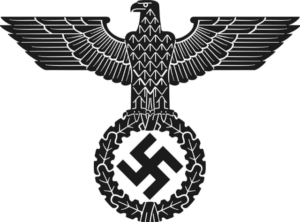Introduction
When you see the Nazi symbol, or the swastika in its Nazi form, it immediately brings chills. It’s one of the most recognizable and feared symbols in the world. But here’s the twist: this wasn’t always the case. The swastika has been around for thousands of years, long before Adolf Hitler adopted it. To truly understand why this symbol became infamous, we need to dive into its history.
What Is the Nazi Symbol?
The Nazi symbol refers to the black swastika tilted at 45 degrees, placed inside a white circle on a red background. While the swastika itself is ancient, this specific version became the official emblem of Adolf Hitler’s Nazi Party. It was designed to represent racial purity, nationalism, and the so-called superiority of the Aryan race.
The Ancient Origins of the Swastika
Long before World War II, the swastika had a completely different meaning. Archaeologists have found it in ruins dating back over 7,000 years. Ancient civilizations used it as a sign of good fortune, prosperity, and life. In Sanskrit, the word swastika literally means “well-being.”
The Swastika in Different Cultures
Hinduism and Buddhism
In India, the swastika is still sacred. In Hinduism, it represents Lord Vishnu and cosmic order. In Buddhism, it symbolizes eternity and spiritual awakening.
Native American Tribes
Tribes such as the Hopi used the swastika as a symbol of migration and balance in nature.
European Traditions
The swastika appeared in ancient Greek pottery, Viking artifacts, and even Celtic designs. It was seen as a sun symbol.
Adoption by the Nazi Party
So why did Hitler and the Nazis hijack the swastika? In his book Mein Kampf, Hitler explained that he chose it because it represented “the struggle for the victory of the Aryan man.” For the Nazis, the swastika was rebranded as a political weapon—a symbol of nationalism and racial supremacy.
The Nazi Flag and Its Design
The flag was not random. Hitler personally designed it.
- Red background: Represented social thought.
- White circle: Nationalism.
- Black swastika: Aryan identity.
Together, this flag became one of the most terrifying banners in human history.
How the Swastika Became Synonymous with Hate
When the Nazis started committing atrocities, the symbol became linked to violence, hatred, and genocide. After the Holocaust, in which six million Jews and millions of others were killed, the swastika was permanently stained with blood.
Impact of the Nazi Symbol on Modern Society
Even today, people feel fear and anger when they see the swastika in its Nazi form. In Europe, especially, it is considered deeply offensive. It’s no longer seen as a neutral cultural symbol in most of the Western world.
Legal Restrictions Around the Nazi Symbol
Germany, Austria, and other European countries have made displaying the Nazi swastika illegal. It’s banned on flags, clothing, and propaganda, except for educational or artistic purposes. In contrast, countries like the U.S. allow it under freedom of speech, though it’s socially condemned.
The Nazi Symbol in Neo-Nazi Movements
Sadly, extremist groups continue to use the Nazi symbol today. Neo-Nazis spray it on walls, use it in rallies, and share it online as a way to intimidate minorities and spread hate.
How Survivors View the Symbol
For Holocaust survivors, the swastika is not just a symbol—it’s a scar. Many survivors say that seeing it brings back memories of concentration camps, lost family, and trauma that never fully heals.
The Difference Between the Swastika and the Nazi Symbol
Here’s where confusion arises: the swastika itself is not evil. Its Nazi version, however, carries an entirely different weight. That’s why it’s important to separate the cultural swastika from the Nazi swastika.
Efforts to Reclaim the Swastika
In India, Japan, and other countries, there are efforts to remind the world of the swastika’s positive origins. Temples still use it proudly, but reclaiming it globally has been difficult because of the strong Nazi association.
The Nazi Symbol in Pop Culture
Movies like Schindler’s List or video games like Call of Duty often feature the Nazi swastika. Sometimes it educates, sometimes it shocks, but it always reminds audiences of the darkest chapter in modern history.
Conclusion
The Nazi symbol is one of the most powerful examples of how a symbol can change meaning. What was once a mark of good luck turned into a universal symbol of hate and violence. Understanding its history is crucial—not to glorify it, but to ensure we never forget the lessons of the past.
FAQs
1. Why did Hitler choose the swastika?
He believed it represented Aryan identity and strength, making it the perfect emblem for Nazi ideology.
2. Is the swastika always linked to Nazis?
No. It has been used in many cultures for thousands of years with positive meanings.
3. Is it illegal to display the Nazi symbol everywhere?
Not everywhere. Countries like Germany ban it, but in the U.S., it’s allowed under free speech laws.
4. How do Hindus and Buddhists view the swastika?
They see it as a sacred sign of good fortune, prosperity, and eternity, completely separate from Nazi use.
5. Can the swastika ever lose its Nazi connection?
Globally, it’s hard. In Western societies, the Nazi association is too strong, but in Asia, it still thrives in its original form.


